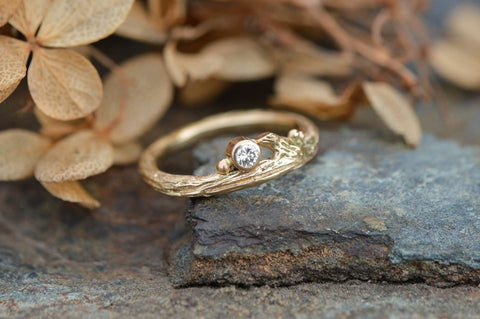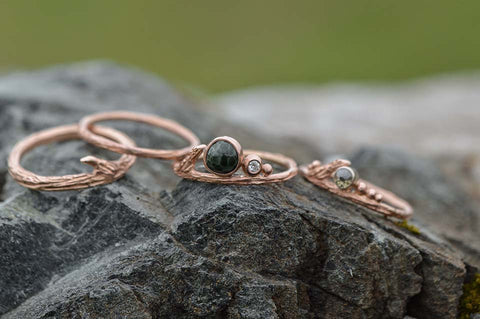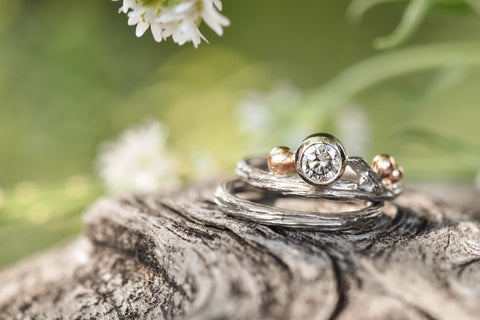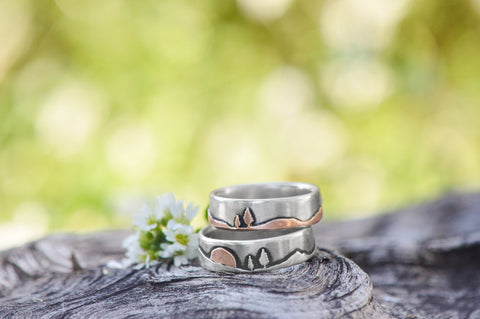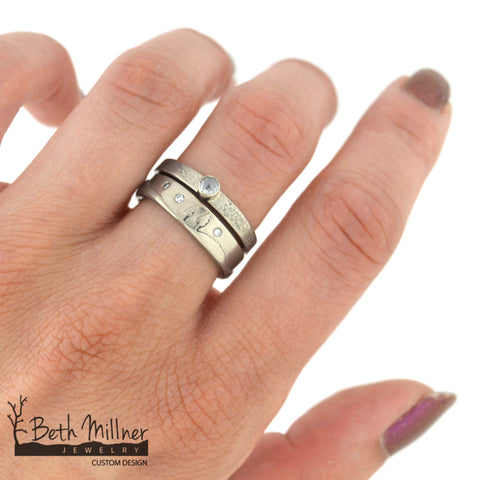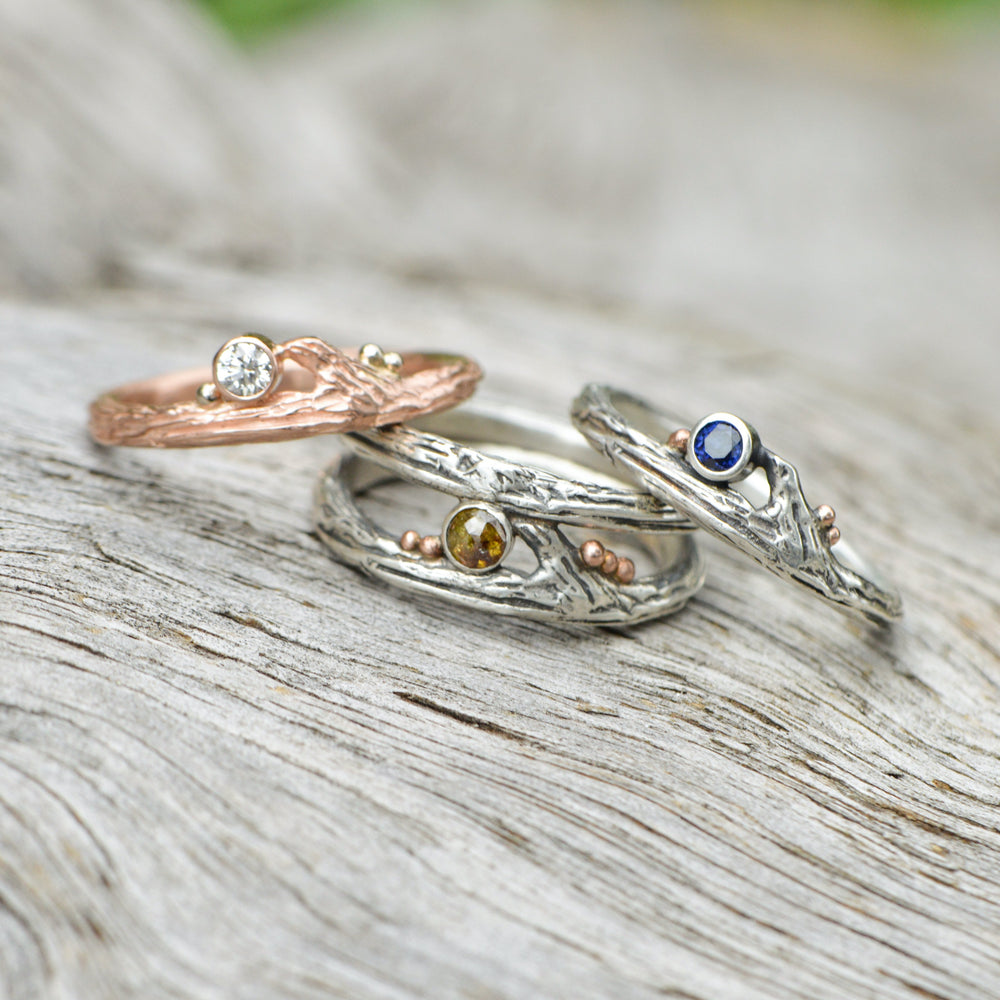
One of our most common customer questions is "How do I choose a metal for an engagement ring or wedding band?" The answer to this largely depends on two things: what is your lifestyle like? and what is your design style? Below we'll go into the pros and cons of each metal that we offer, and help you make the best decision for you!
1. Sterling Silver
Sterling silver is the softest metal that we offer. Soft doesn't mean that it isn't relatively durable, however, it is the most susceptible to scratching and showing wear and tear, and is not ideal for very thin rings. Our Narrow Twig rings, Gold Delicate Dewdrop ring , and our Gold Enchanted Rustic Diamond Twig Ring cannot be made in silver because of the narrow band width.
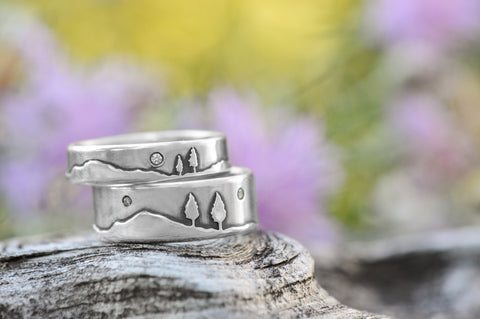
No matter the width of your silver ring, after wearing for some time it will conform to your finger and oval out a bit. This does not affect the integrity of the ring although some people prefer to have us round the ring out if it becomes too oval or misshapen.
Silver does hold a patina, which is a naturally occurring oxidization that we intentionally apply to darken recessed areas and create depth in the design. Gold does not patina, and doesn't have this benefit. Further, as silver scratches over time it creates a unique wear pattern that some people find desirable. And finally, silver is a more affordable option over gold.
To sum up silver, it's a great option if you like the way that it looks. You may have to replace your silver wedding ring at some point in your lifetime if you are particularly hard on your rings, and may need to consider how well the particular design you're interested in will hold up if made in silver. However, with a little bit of care, silver can and does last a lifetime.
2. 14K and 18K Yellow Gold
Next up we have 14K and 18K yellow gold. You might be wondering, what is the difference? Well, gold is a very soft metal by itself, and would not be ideal for a wedding band or engagement ring. So, it is almost always alloyed (mixed) with other metals to give it more durability, and these additional metals can also cause small changes in color that might be desirable. 18K gold has less alloy metal than 14K, and so it is a bit softer. However, because 18K has a higher ratio of gold, it is also richer in color, and some people prefer the deeper yellow.
Again, this is really a question of preference. If you are hard on your rings or work with your hands, you might consider choosing 14K. However, in a sturdier design, you can feel comfortable choosing 18K if you prefer the color.
With gold being a more durable metal, your gold ring will keep its round shape during normal long term wear.
A final consideration for choosing 18K gold is cost. Because it is a higher ratio of gold, 18K is more expensive. The difference in color is also fairly subtle, and because of these two factors we generally work with 14K for that little bit of extra durability and the bonus affordability.
3. 14K Rose Gold
Rose gold is a great option because it is both durable, and has a gorgeous copper color. We often get asked if we make copper rings, and the answer is no. When copper is directly against the skin in areas that experience a lot of friction, it can cause an allergic reaction. Copper is a softer metal than even silver so it is not ideal for long term wear for that reason as well. Because of this, we recommend rose gold for rings. Rose gold is actually a combination of gold and copper, and retains the color of copper with the hypoallergenic benefits of gold.
Why don't we work with 18K rose gold? Because the color difference is extremely subtle, and 14K is more durable and affordable.
4. 14K and 18K Palladium White Gold
White gold is great because it has the appearance of silver with the strength of gold, and white gold that has been alloyed with palladium is particularly strong. Generally, we work with 14K Palladium White Gold because it has a slightly brighter finish and warmer color. Frequently, jewelry stores will coat white gold with Rhodium to create a whiter finish, but this is a plate and will wear off and need to be replaced. We love the natural color of palladium white gold and know that most of our customers want simple, practical designs that don't require a lot of upkeep.
If the ring we are creating is made through the casting process, we only use 18K palladium due to its better ability to be cast. If the ring we are creating is made through hand fabrication (starting with flat sheets or wires) we use 14K palladium.
5. Mixed Metal - Silver with Gold Accents or Gold with other Gold Accents
Beth's iconic mixed metal style is unique and distinct, making it a desirable design element we often are asked about. At Beth Millner Jewelry, mixed metal refers to different metal layers or accents and not an alloy.
Mixed metal with silver and gold gives the benefit of a lower cost than an all gold ring while still giving the design the iconic "pop" of different colors. We particularly like rose or yellow gold landscapes on a silver band, as it allows for the patina of the silver to hold around the edges of the landscape layer.
Mixing different layers of gold gives a ring the full benefit of durability and creates a unique ring, although because gold does not hold a patina, the layers are more subtle.
So what metal should you choose? The one that works the best for your lifestyle, personal design preferences, and budget. We have a variety of rings in each of these metals, and can even create custom designs. For more information, check out our posts about ring sizing and gemstone options.




